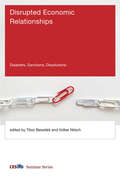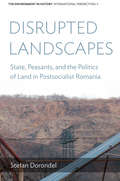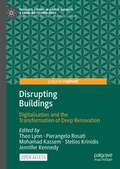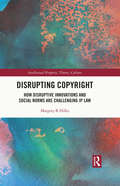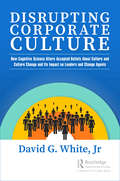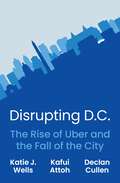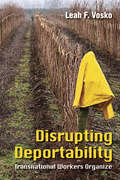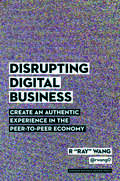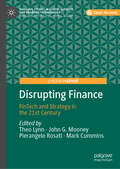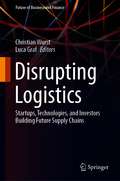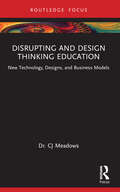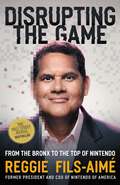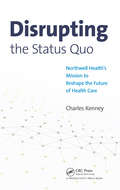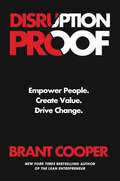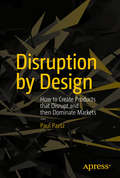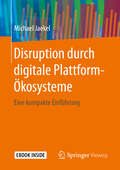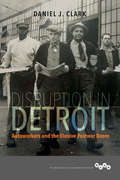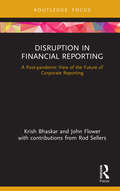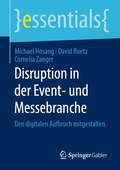- Table View
- List View
Disrupted Development and the Future of Inequality in the Age of Automation (Rethinking International Development series)
by Andy Sumner Lukas SchloglThis open access book examines the future of inequality, work and wages in the age of automation with a focus on developing countries. The authors argue that the rise of a global ‘robot reserve army’ has profound effects on labor markets and economic development, but, rather than causing mass unemployment, new technologies are more likely to lead to stagnant wages and premature deindustrialization. The book illuminates the debate on the impact of automation upon economic development, in particular issues of poverty, inequality and work. It highlights public policy responses and strategies–ranging from containment to coping mechanisms—to confront the effects of automation.
Disrupted Economic Relationships: Disasters, Sanctions, Dissolutions (CESifo Seminar Series)
by Enrico SpolaoreEmpirical studies and theoretical analyses examine the causes and consequences of disruptions in cross-border economic relationships, including political conflict, economic sanctions, and institutional collapse.Cross-border economic relationships gradually strengthened in the decades after World War II; for most of the postwar period, international trade and investment have grown faster than output, a process often termed “globalization.” In recent years, however, economic relationships have grown more fragile, subject to disruption by such factors as political conflict, economic sanctions, and the dissolution of institutional arrangements. This timely CESifo volume offers empirical studies and theoretical analyses that examine the causes and consequences of these disrupted economic relationships.Contributors propose a new theoretical framework for understanding the economic impact of intergroup conflict and develop a predictive model to analyze the contagion of regional wars. They offer empirical studies of the economic effect of targeted sanctions and boycotts, including those imposed upon Iran, Russia, and Myanmar; argue provocatively that natural disasters are associated with increased international trade; analyze trade duration, finding previously identified explanatory factors to be insufficient for explaining variations in trade survival over time; and critically review the hypothesis that oil was a crucial factor in the collapse of the Soviet Union.ContributorsDaniel P. Ahn, Tibor Besedeš, Kilian Heilmann, Wolfgang Hess, Julian Hinz, Melise Jaud, Tristan Kohl, Madina Kukenova, Chenmei Li, Rodney D. Ludema, Volker Nitsch, Maria Persson, Chiel Klein Reesink, Arthur Silve, Enrico Spolaore, Martin Strieborny, Marvin Suesse, Peter A. G. van Bergeijk, Thierry Verdier, Romain Wacziarg
Disrupted Landscapes: State, Peasants and the Politics of Land in Postsocialist Romania
by Stefan DorondelThe fall of the Soviet Union was a transformative event for the national political economies of Eastern Europe, leading not only to new regimes of ownership and development but to dramatic changes in the natural world itself. This painstakingly researched volume focuses on the emblematic case of postsocialist Romania, in which the transition from collectivization to privatization profoundly reshaped the nation's forests, farmlands, and rivers. From bureaucrats abetting illegal deforestation to peasants opposing government agricultural policies, it reveals the social and political mechanisms by which neoliberalism was introduced into the Romanian landscape.
Disrupting Buildings: Digitalisation and the Transformation of Deep Renovation (Palgrave Studies in Digital Business & Enabling Technologies)
by Theo Lynn Pierangelo Rosati Mohamad Kassem Stelios Krinidis Jennifer KennedyThe world’s extant building stock accounts for a significant portion of worldwide energy consumption and greenhouse gas emissions. In 2020, buildings and construction accounted for 36% of global final energy consumption and 37% of energy related CO2 emissions. The EU estimates that up to 75% of the EU’s existing building stock has poor energy performance, 85–95% of which will still be in use in 2050.To meet the goals of the Paris Agreement on Climate Change will require a transformation of construction processes and deep renovation of the extant building stock. It is widely recognized that ICTs can play an important role in construction, renovation and maintenance as well as supporting the financing of deep renovation. Technologies such as sensors, big data analytics and machine learning, BIM, digital twinning, simulation, robots, cobots and UAVs, and additive manufacturing are transforming the deep renovation process, improving sustainability performance, and developing new services and markets.This open access book defines a deep renovation digital ecosystem for the 21st century, providing a state-of-the art review of current literature, suggesting avenues for new research, and offering perspectives from business, technology and industry domains.This is an open access book.
Disrupting Copyright: How Disruptive Innovations and Social Norms are Challenging IP Law (Intellectual Property, Theory, Culture)
by Margery R HilkoNew innovations are created every day, but today’s business leaders are focused on finding disruptive innovations which are cheaper and lower performing than upmarket technologies. They create new markets, and challenge the status quo of existing technological thinking creating uncertainty both in the future of the innovation and the outcome of the market upheaval. Disruptive innovation is an influential innovation theory in business, but how does it affect the law? Several of these technologies have brought new ways for individuals to deal with copyright works while disrupting existing market expectations, while their ability to spawn social norms has presented challenges for legislation. Considering disruptive innovation as a class, this book examines innovations that have impacted copyright in the past, what lessons can be learned from how the law interacted with them, and how the law can successfully deal with them going forward. Creating comprehensive guidance that can be used when faced with disruptive innovations with the aim of more successful legislation, it considers whether copyright law itself has been disrupted through these innovations. Exploring whether disruptive innovations as a class have unique properties that necessitate action by legislators and whether these properties have the possibility to disrupt the law itself, this book theorises how the law should deal with disruptive innovations in general, going beyond a discussion of the regulation of specific innovations to develop a framework for how law makers should deal with disruptive innovations when faced by one.
Disrupting Corporate Culture: How Cognitive Science Alters Accepted Beliefs About Culture and Culture Change and Its Impact on Leaders and Change Agents
by David G. White, JrResearch in cognitive science over the last 30 years shows much of what we know about culture in the business world is based on myth, wishful thinking, outdated science, or is just plain wrong. This is why culture-shaping and change programs in organizations often amount to little more than sloganeering with minimal impact on the lived experience of employees. This book bridges the gap between the latest research on cognitive science and culture, providing a valuable guide for change leaders, CEOs, and practitioners on how to sustainably work with and change this important resource. It answers many of the major questions that have plagued culture work, such as: Why so many CEOs and management consultants preach culture change when so few culture interventions actually succeed Why CEOs persist in believing "culture starts at the top" when virtually no research in anthropology supports that claim Why most culture shaping approaches have no answer for how to affect culture in global companies Why culture doesn’t cause us to do anything, yet we persist in believing that somehow it does Why so many culture-shaping projects focus on corporate values despite the fact modern science shows why changing personal values is exceedingly difficult What we are learning about culture from the last 30 years of cognitive science gives us the foundation for far more impactful and sustainable interventions than have been possible to date. This book explains why, showing how everyday business practices well beyond HR are key to culture change. Why? Because the brain’s synaptic plasticity can only be altered through new sustained and widespread organizational habits and routines. This groundbreaking, practical guide will show you finally how to realize the full power of culture as a transformational, empowering, and competitive resource.
Disrupting D.C.: The Rise of Uber and the Fall of the City
by Katie J. Wells Kafui Attoh Declan CullenA panoramic account of the urban politics and deep social divisions that gave rise to UberThe first city to fight back against Uber, Washington, D.C., was also the first city where such resistance was defeated. It was here that the company created a playbook for how to deal with intransigent regulators and to win in the realm of local politics. The city already serves as the nation&’s capital. Now, D.C. is also the blueprint for how Uber conquered cities around the world—and explains why so many embraced the company with open arms.Drawing on interviews with gig workers, policymakers, Uber lobbyists, and community organizers, Disrupting D.C. demonstrates that many share the blame for lowering the nation&’s hopes and dreams for what its cities could be. In a sea of broken transit, underemployment, and racial polarization, Uber offered a lifeline. But at what cost?This is not the story of one company and one city. Instead, Disrupting D.C. offers a 360-degree view of an urban America in crisis. Uber arrived promising a new future for workers, residents, policymakers, and others. Ultimately, Uber&’s success and growth was never a sign of urban strength or innovation but a sign of urban weakness and low expectations about what city politics can achieve. Understanding why Uber rose reveals just how far the rest of us have fallen.
Disrupting Defense at Anduril Industries
by Rory McDonald Aditi Ghai James Heffelfinger Timothy BuehnCase
Disrupting Deportability: Transnational Workers Organize
by Leah F. VoskoIn an original and striking study of migration management in operation, Disrupting Deportability highlights obstacles confronting temporary migrant workers in Canada seeking to exercise their labor rights. Leah F. Vosko explores the effects of deportability on Mexican nationals participating in Canada's Seasonal Agricultural Worker Program (SAWP).Vosko follows the decade-long legal and political struggle of a group of Mexican SAWP migrants in British Columbia to establish and maintain meaningful collective representation. Her case study reveals how modalities of deportability—such as termination without cause, blacklisting, and attrition—destabilize legally authorized temporary migrant agricultural workers. Through this detailed exposé, Disrupting Deportability concludes that despite the formal commitments to human, social, and civil rights to which migration management ostensibly aspires, the design and administration of this "model" temporary migrant work program produces conditions of deportability, making the threat possibility of removal ever-present.
Disrupting Digital Business
by R Ray" WangWe are no longer an economy of products and services. The digital transformation demands that we focus our attention on experiences and outcomes. Business leaders and their organizations must shift to keeping promises-no matter how their customers interact with them.But organizations no longer control the conversation. In this era of social and mobile technology, customers, employees, suppliers, and partners are in direct communication with one another. Those personal networks and the brands they're passionate about influence their decision making and their spending.The workforce has changed too. Employees expect to be able to determine when and how they will work, the technology they'll use, and the values their company will espouse.Organizations can take part in this conversation only if they recognize how and where it's happening. Resisting these changes will leave executives, managers, and their companies powerless. Organizations must pivot with and ahead of these social, organizational, and technological shifts or risk being left behind.Technology guru Ray Wang shows how organizations can surf the waves of change-how they can keep their promises. Current trends, when taken seriously, require a new way of thinking about business that includes five key areas:1. Consumerization of technology and the new C-suite2. Data's influence in driving decisions3. Digital marketing transformation4. The future of work5. Matrix commerceDigital disruption has changed how we do our work. But by mastering these trends you'll delight your customers with every interaction.
Disrupting Finance: FinTech and Strategy in the 21st Century (Palgrave Studies in Digital Business & Enabling Technologies)
by Mark Cummins Theo Lynn John G. Mooney Pierangelo RosatiThis open access Pivot demonstrates how a variety of technologies act as innovation catalysts within the banking and financial services sector. Traditional banks and financial services are under increasing competition from global IT companies such as Google, Apple, Amazon and PayPal whilst facing pressure from investors to reduce costs, increase agility and improve customer retention. Technologies such as blockchain, cloud computing, mobile technologies, big data analytics and social media therefore have perhaps more potential in this industry and area of business than any other. This book defines a fintech ecosystem for the 21st century, providing a state-of-the art review of current literature, suggesting avenues for new research and offering perspectives from business, technology and industry.
Disrupting Justice at RightNow: Persevere, Pivot or Perish
by Shikhar Ghosh Amir Reza RezvaniThe case examines the focus of an early stage company, and how an unexpected external incidence can threaten or void the business model. It encompasses issues such as defining and pivoting a business model, organizational requirements for a pivot, investor relations, disruptive business models, as well as business conduct in continental Europe. In 2017, Dr. Torben Antretter, a former competitive tennis player and academic researcher, founded RightNow with his two co-founders. RightNow was set out to provide consumers with "Justice-as-a-Service" by purchasing their legal claims that they would not pursue otherwise. Just one year after its inception, the company had closed a 25 million financing to increase its market share and leverage further growth opportunities. Upon closing of this financing round, matters took a sudden and unexpected turn when the National Supreme Court announced a ruling that airlines were no longer required to refund flight tickets. This decision wiped out RightNow's profit margins. Antretter and his co-founders had to decide what they should do with the business. How should the founders approach investors? Should they quit and walk away from their entrepreneurial dream or try to reinvent the business with a different focus? What would be the strategy going forward?
Disrupting Justice at RightNow: Rich or King
by Shikhar Ghosh Amir Reza RezvaniThe case examines issues such as cascading problems within the organization, changing founder roles, founder success criteria, as well as company exit consideration. In 2017, Dr. Torben Antretter, a former competitive tennis player and academic researcher, founded RightNow with his two co-founders. RightNow was set out to provide consumers with "Justice-as-a-Service" by purchasing their legal claims that they would not pursue otherwise. Three years after inception and after overcoming numerous consecutive hurdles, the company was entering its next stage of its lifecycle. The selection of an investor type would be instrumental to the next few years of the company and the lives of the founders. With success, considerations around company exit and defining success criteria became inevitable. Different investors types had different investment criteria with regards to target returns, growth ambitions, decision rights, and ownership stakes. Antretter and his co-founders had to decide, jointly as well as individually, what they want to do. Discussions among the founding team showed that they needed to develop an 'exit strategy' in the same way that they had developed a growth strategy. When should they consider an exit and take some chips off the table? Was it more important to become rich or to remain kings of their kingdom?
Disrupting Logistics: Startups, Technologies, and Investors Building Future Supply Chains (Future of Business and Finance)
by Christian Wurst Luca GrafThis book presents trends, developments, and examples of how digital disruption is currently reshaping the logistics industry. Logistics is the invisible force behind the global economy, influencing and providing a lens into all economic activities. Chapters written by respected experts in the field describe how new technologies such as autonomous vehicles, blockchain, Internet of things (IoT), and state-of-the-art freight management solutions are fundamentally changing supply chain solutions. Special emphasis is placed on promising start-ups and venture capital firms around the world that are now investing in the future of logistics."Supply chains hold significant room for optimization to the benefit of customers, industry participants, authorities and the environment. This book provides a unique set of perspectives from industry leaders covering a wide range of topics. It is a ‘must read’ for anyone seeking to understand and contribute to a better tomorrow in supply chains logistics." — Thomas Bagge, Chief Executive Officer and Statutory Director DCSA“The need for standardisation and digitalisation in logistics is no longer an option. This book gives insights from industry experts, shows trends and innovations in platforms, underlines the need for transparency and how big data and analytics can make a world of difference. It’s an incredible resource if you wish to better understand the new normal of logistics.” — Global Chief Digital & Information Officer, MSC Mediterranean Shipping Company"This book presents readers with a straightforward and comprehensive assessment of supply chain innovation and trends and their impact on the industry. With contributions from several industry leaders, it provides critical knowledge and insight that supply chain and logistics managers need to implement disruptive technologies strategically.” — Rene Jacquat, Founder / Advisor, LogiChain Solutions
Disrupting and Design Thinking Education: New Technology, Designs, and Business Models (Routledge-Solaris Focus on Strategy, Wisdom and Skill)
by CJ MeadowsMeadows proposes an approach to the education business that begins with needs, and proposes educational and business models, supported by new technologies. This book takes a design-thinking and disruption perspective on the future of education. Beginning with shocking statistics on cost, time, and lengthy debt repayment, it presents a clear case for disruption in the education sector. It continues by examining future skills in the age of AI, machine learning, and robotics. In this new age, businesses need a new kind of workforce, and workers need to equip themselves to survive and thrive. Drawing upon tools and techniques from disruption and design-thinking, Meadows puts forward new frameworks of education, business, and technology -- all with examples of educators (and learners) already doing it today.This book provides rigorous thinking and practical guidance for professionals in the education industry and budding education entrepreneurs, as well as homeschooling parents.
Disrupting the Game: From the Bronx to the Top of Nintendo
by Reggie Fils-AiméReggie Fils-Aimé, retired President and Chief Operating Officer of Nintendo of America Inc., shares leadership lessons and inspiring stories from his unlikely rise to the top. Although he&’s best known as Nintendo's iconic President of the Americas-immortalized for opening Nintendo&’s 2004 E3 presentation with, &“My name is Reggie, I'm about kicking ass, I'm about taking names, and we're about making games&”-Reggie Fils-Aimé&’s story is the ultimate gameplan for anyone looking to beat the odds and achieve success.Learn from Reggie how to leverage disruptive thinking to pinpoint the life choices that will make you truly happy, conquer negative perceptions from those who underestimate or outright dismiss you, and master the grit, perseverance, and resilience it takes to dominate in the business world and to reach your professional dreams.As close to sitting one-on-one with the gaming legend as it gets, you will learn:About the challenges Reggie faced throughout his life and career-from his humble childhood as the son of Haitian immigrants, to becoming one of the most powerful names in the history of the gaming industry.What it takes to reach the top of your own industry, including being brave enough to stand up for your ideas, while also being open to alternative paths to success.How to create vibrant and believable visions for your team and company.How to maintain relentless curiosity and know when to ask questions to shatter the status quo.
Disrupting the Meat Industry: Tissue Culture Beef
by Matthew Preble Jose B. AlvarezDr. Mark Post and his team at Maastricht University were perfecting their tissue culture beef product-made entirely from muscle grown in his lab-to give it the same taste, texture and appearance of a traditional beef hamburger. A previous iteration of this product had been taste tested live, with good results, and Sergey Brin, a co-founder of Google, had provided Post with much of the funding to make the burgers. The next step was to form an independent company around this technology and take it to market. This innovative product could both radically disrupt the existing beef production and supply chain, and provide an animal welfare and environmentally-friendly food that had far less of an environmental impact than traditional beef products. Post faced several challenges in making this a commercially viable product though. He had to get price down, as it currently cost roughly $330,000 to make a single burger. He also had to find the right partner(s) to help him bring the product to market, but who should he work with: someone from the established beef production and supply system, a retailer, or someone entirely outside the traditional beef system? How could he expect established companies to react to this disruption of the status quo? Messaging around this product was critical: How should Post communicate with the public to convey that this was a natural product-the way muscle tissue grew in his lab was the same way it developed in cattle-and overcome public skepticism of overt scientific involvement in their food?
Disrupting the Status Quo: Northwell Health's Mission to Reshape the Future of Health Care
by Charles KenneyWe are in the midst of what may well be the most confusing, turbulent period in the history of modern medicine. This book seeks to cut through the fog and confusion that enshrouds the health care industry to provide clarity on where the industry stands today and where it is headed. The book defines the major challenges in health care through the journey of Northwell Health, one of the largest provider organizations in the country. The central issues in what is nearly one-fifth of the United States economy are played out daily within this not-for-profit organization. Northwell is New York state’s largest workers, and $11 billion in annual revenue. The book candidly portrays key leaders within Northwell on the most vexing challenges in health care: How to provide primary and specialty care spending; how to create and sustain an internal system of continuous learning to enable employees at all levels to stay current in an industry that is changing at warp speed; how to provide emergency services in a world where natural disasters and acts of terrorism are inevitable; how to identify new revenue streams to offset reductions from Medicare and Medicaid; and how to push outside the walls of hospitals and clinics to improve the overall health of individuals and communities by working on determinants of health beyond the typical medical practice. The book exists at the intersection of medicine, business, social and public policy. Harvard’s Michael Porter has written widely on health care arguing that it is time "for a fundamentally new strategy," but what, exactly? Where is the industry headed? What do the changes and the turbulence mean for patients, doctors, nurses? This book is the product of a learning journey both humbling and rewarding. Over time, lessons learned, improvements made, innovations conceived, have advanced Northwell Health in ways that, some years ago, might not have seemed possible. Northwell has become a national leader not because it is perfect, but because it remains steadfast in its journey to remain humble enough to know that whatever success may be achieved, the journey is about continuous learning and improvement. The goal of the book is to provide a deeper, clearer understanding of what is happening in health care and why; to help illuminate a pathway forward for patients and caregivers most of all, but also for policy-makers and the employers and others who pay for care.
Disruption Proof: Empower People, Create Value, Drive Change
by Brant CooperCEO and founder of Moves the Needle and New York Times bestselling author of The Lean Entrepreneur Brant Cooper teaches leaders how to ensure their organizations are resilient, agile, and dynamic enough to endure long-term, weathering the storms of disruption and uncertainty. One thing in life is certain: change is constant. Thanks to the rapid pace of technological innovation in the digital age—and further accelerated by the global COVID-19 pandemic—massive structural change is happening on a greater scale than ever before. Faced with unprecedented complexity and uncertainty, most business leaders struggle to see the way forward. Company organization, systems, and management are still largely based on what was most effective in the Industrial Age. Disruption Proof offers a new approach that addresses our current reality. Through powerful case studies of notable corporations like Intuit, 3M, Cargill, and more, Cooper demonstrates how, with the right mindset and practical strategies, companies that focus on creating value for customers can thrive in the 21st century. Disruption Proof provides readers with detailed methods for progressing through four stages of implementation to embrace a new way of working company-wide, including how to: develop an understanding of customers and colleagues that lead to insights (empathy)run tests to challenge assumptions (exploration)leverage data and insights to breakthrough biases (evidence)balance operational execution with learning (equilibrium)manage behavior to match corporate values (ethics) By adopting these 5Es, company leaders can empower employees to become creative problem solvers, ensuring their company&’s ability to navigate moments of crisis and find transformative opportunities. Cooper explains how reimagining work at every level is the key to organic and sustainable growth, and guides leaders to create lasting value in the world. With Cooper's action-oriented advice and tools, anyone can help steer their company towards durable success.
Disruption Spreads Its Wings: The Future of Aviation
by Clayton M. Christensen Scott D. Anthony Erik A. RothThe dynamics of disruption have been playing out dramatically in the aviation industry. This chapter describes how regional jet manufacturers have encroached on the established market, how incumbents are hindered by their processes and structures, and how incumbents are responding to the disruption.
Disruption by Design
by Paul PaetzFrom Eli Whitney to Henry Ford to Ray Kroc to Steve Jobs, market disruptors have reaped the benefits, including fame and fortune. But do you have to be that rare genius whose unique skills can literally change the world? No. Disrupting a market is a discipline that can be learned. Disruption by Design--a handbook for entrepreneurs, CEOs, product developers, innovators, and others who want to build products or create services that systematically disrupt markets--is the first book that shows you how. There is a huge difference between being an 'innovator' and being a 'disruptive innovator. ' Disruptors change the basis for competition in markets, and they end up controlling market share--typically 40 to 80% of the total revenue and half or more of the total profits in the categories they create. But while many market opportunities have disruptive potential, only a small fraction of those ever succeed in disrupting markets. And, too often, those that do disrupt do so by accident. It doesn't have to be that way. Disruption by Design conveys lessons learned from successful disruptors, and from the many companies that should have disrupted but failed. Beginning with a quick review of the theory and key elements of the patterns of disruptive innovations and how to identify ideas with disruptive potential, Disruption by Design guides you through the design, build, and go-to-market phases that successful disruptors follow. Using many examples of disruptive companies and products, this book takes the popular theory of disruptive innovation and drives it down to the level of practical application. It answers the question, 'How do I create a disruptive company, product, and culture?' Disruption by Design:
Disruption durch digitale Plattform-Ökosysteme: Eine kompakte Einführung
by Michael JaekelDisruption ist das Schlagwort einer Digitalmoderne, in der digitale Plattform-Ökosysteme eine neue Ökonomie erzeugen. Es expandiert eine Plattform-Ökonomie, die etablierte Unternehmen und Industrien in ihren Grundfesten erschüttert. Die Erschütterungen werden von dem Phänomen der Disruption ausgelöst. In Literatur und Praxis wird der Begriff der Disruption aber inflationär für nahezu alles herangezogen. Daher zielt das vorliegende kompakte Buch auf die kohärente Klärung des Begriffs der Disruption als ein Axiom der Digitalmoderne ab. Zudem erläutert der Autor die Expansionsdynamiken digitaler Plattform-Öko-Systeme durch Big Data-Management und Anwendungen der schwachen Künstlichen Intelligenz. Die Ausführungen zeigen die Relevanz der Disruptionstheorie praxisorientiert am Beispiel der digitalen Transformation eines großen Verlagshauses. Der Autor bietet mit seinem Werk Denkwerkzeuge und -anregungen, jedoch keinen schablonenhaften Ratgeber. Damit richtet sich das Buch an alle, die sich mit disruptiven Dynamiken der Digitalisierung kritisch auseinandersetzen und eigene Gedanken weiterentwickeln möchten.
Disruption in Detroit: Autoworkers and the Elusive Postwar Boom (Working Class in American History #288)
by Daniel J. ClarkIt is a bedrock American belief: the 1950s were a golden age of prosperity for autoworkers. Flush with high wages and enjoying the benefits of generous union contracts, these workers became the backbone of a thriving blue-collar middle class. It is also a myth. Daniel J. Clark began by interviewing dozens of former autoworkers in the Detroit area and found a different story--one of economic insecurity caused by frequent layoffs, unrealized contract provisions, and indispensable second jobs. Disruption in Detroit is a vivid portrait of workers and an industry that experienced anything but stable prosperity. As Clark reveals, the myths--whether of rising incomes or hard-nosed union bargaining success--came later. In the 1950s, ordinary autoworkers, union leaders, and auto company executives recognized that although jobs in their industry paid high wages, they were far from steady and often impossible to find.
Disruption in Financial Reporting: A Post-pandemic View of the Future of Corporate Reporting (Disruptions in Financial Reporting and Auditing #3)
by John Flower Krish BhaskarSince the global financial crisis of 2007–8, new laws and regulations have been introduced with the aim of improving the transparency in financial reporting. Despite the dramatically increased flow of information to shareholders and the public, this information flow has not always been meaningful or useful. Often it seems that it is not possible to see the wood for the trees. Financial scalds continue, as Wirecard, NMC Health, Patisserie Valerie, going back to Carillion (and many more) demonstrate. Financial and corporate reporting have never been so fraught with difficulties as companies fail to give guidance about the future in an increasingly uncertain world aided and abetted by the COVID-19 pandemic. This concise book argues that the changes have simply masked an increase in the use of corporate PR, impression management, bullet points, glossy images, and other simulacra which allow poor performance to be masked by misleading information presented in glib boilerplate texts, images, and tables. The tone of the narrative sections in annual reports is often misleading. Drawing on extensive research and interviews with insiders and experts, this book charts what has gone wrong with financial reporting and offers a range of solutions to improve information to both investors and the public. This provides a framework for a new era of forward-looking corporate reporting and guidance based on often conflicting multiple corporate goals. The book also examines and contrasts the latest thinking by the regularity authorities. Providing a compelling exploration of the industry’s failings and present difficulties, and the impact of future disruption, this timely, thought-provoking book will be of great interest to students, researchers, and professionals as well as policy makers in accounting, financial reporting, corporate reporting, financial statement analysis, and governance.
Disruption in der Event- und Messebranche: Den digitalen Aufbruch mitgestalten (essentials)
by Cornelia Zanger David Ruetz Michael HosangDieses essential beschreibt, inwieweit Digitalisierungsprozesse sowie disruptive Technologien in der Event- und Messebranche bereits angestoßen und umgesetzt werden und beantwortet die folgenden Fragen: Wie reagieren Event- und Messeteilnehmer und teilnehmerinnen auf den Einsatz der neuen Technologien? Welche Rolle spielen digitale Tools im Hinblick auf Kaufentscheidungen und mit welchen neuen Anforderungen müssen sich Mitarbeiter und Mitarbeiterinnen aufgrund stetiger Anpassungen an veränderte Arbeitsweisen auseinandersetzen?

